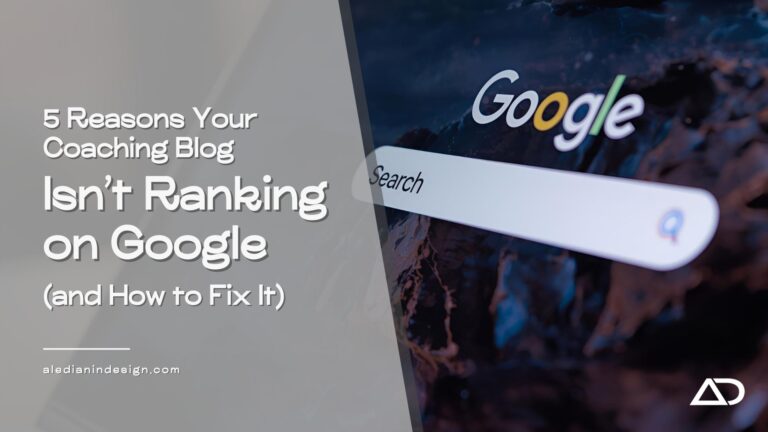
Blogging for Coaches: How to Stop Overthinking and Start Getting Found
You stare at the blinking cursor, wondering if anyone’s even going to read this blog post… Sound familiar?
If you’re a coach, nutritionist, or solopreneur, chances are you’ve had this exact moment. Maybe you’ve even closed your laptop, convinced that blogging is just another marketing task that successful people do, but not something that will actually work for your business.
Here’s the truth: you’re not alone in feeling this way. But you’re also missing out on one of the most powerful tools for building your coaching practice.
The Real Problem: You're Flying Blind
Why Most Coach Blogging Strategies Fail
Most coaches approach blogging in one of two ways, and both are setting you up for frustration:
Option 1: The Random Post Approach
You write when inspiration strikes. Maybe it’s a breakthrough moment with a client, or something you learned at a conference. You pour your heart into a 1,500-word post about “Finding Your Why” or “The Power of Mindset,” hit publish, and… crickets.
Option 2: The Paralysis Approach
You know you should be blogging, but the thought of creating consistent content feels overwhelming. So you don’t start at all. Meanwhile, your ideal clients are searching Google for solutions you could easily provide.
Both approaches miss the mark because they ignore a fundamental truth: Google doesn’t favour random posts, it wants relevance and structure. And your ideal clients aren’t just browsing aimlessly; they’re actively searching for specific solutions to their problems.
What Blogging Should Actually Do for Your Coaching Business
Let’s reframe blogging from “another thing on my to-do list” to “one of the most powerful assets in your business.”
Support Your Services Directly
Every blog post should connect to something you offer. If you’re a life coach who helps people with career transitions, your post about “5 Signs It’s Time for a Career Change” should naturally lead to your career clarity coaching package.
Build Trust Before the Sales Call
Potential clients want to know you understand their struggles before they book a discovery call. When someone finds your blog post about overcoming imposter syndrome and sees you’ve helped dozens of clients through the same challenge, they’re already halfway to trusting you.
Work Passively While You Sleep
This is where SEO becomes your best friend. A well-optimised blog post can continue attracting your ideal clients months or even years after you publish it. Imagine waking up to enquiry emails from people who found your post at 2 AM and realised you’re exactly what they’ve been looking for.
3 Practical Tips to Blog Better as a Coach
1. Choose Topics Based on What Clients Are Actually Googling
Stop guessing what your audience wants to read. Start with real search behaviour.
Try this exercise:
Open Google and type “how to” followed by your main area of expertise. If you’re a relationship coach, try “how to communicate better in relationships” or “how to rebuild trust after an argument with my boss.” Google’s autocomplete suggestions show you exactly what people are searching for.
Real example:
A nutrition coach I know was writing posts about “superfoods” and “clean eating myths.” Then she researched what her ideal clients were actually searching for: “how to meal prep when you hate cooking” and “healthy snacks for busy mums.” Her traffic and client enquiries tripled when she switched focus.
Pro tip:
Use tools like AnswerThePublic, Reddit or simply scroll through Facebook groups where your ideal clients hang out. What questions come up repeatedly? Those are your blog topics.
2. Link Each Post to a Service or Lead Magnet
Never publish a blog post without a clear next step for readers.
The strategic approach:
- Top of funnel posts (awareness stage) → Lead magnet signup
- Middle of funnel posts (consideration stage) → Service page or case study
- Bottom of funnel posts (decision stage) → Discovery call booking
Example:
Let’s say you’re a business coach writing about “How to Price Your Services Without Undervaluing Yourself.” At the end, you might say: “Ready to create a pricing strategy that reflects your true value? Download my free Pricing Confidence Calculator [link to lead magnet] or book a strategy session to discuss your specific situation [link to booking page].”
The key insight:
Don’t just educate! Guide people toward working with you.
3. Use Your Content More Than Once
Creating a blog post is just the beginning. Smart coaches extract maximum value from every piece of content.
The multiplication strategy:
- Blog post → becomes the foundation
- Newsletter → summarise key points with a personal story
- Instagram carousel → break down into digestible slides
- LinkedIn article → adapt for a professional audience
- YouTube video → expand with case studies and examples
- Podcast episode → dive deeper into the topic
Real example: A wellness coach wrote a blog post about “Creating Morning Routines That Actually Stick.” She then:
- Sent it as her weekly newsletter with a personal story about her own morning routine evolution
- Created an Instagram reel showing her 5-minute morning routine for busy days
- Turned it into a LinkedIn article focused on morning routines for entrepreneurs
- Recorded a podcast episode interviewing clients about their successful morning routines
One blog post became six pieces of content across different platforms, all driving traffic back to her coaching services.
The Mindset Shift That Changes Everything
Stop thinking of blogging as “content creation” and start thinking of it as “client attraction.”
Every post is an opportunity to:
- Demonstrate your expertise without giving everything away for free
- Show potential clients you understand their specific challenges
- Build the know, like, and trust factor that turns strangers into clients
- Create valuable resources you can reference during sales conversations
When a potential client finds your blog post about exactly the challenge they’re facing, they’re not just reading content, they’re experiencing what it might be like to work with you.
Your Next Steps
Blogging for coaches isn’t about perfect prose or viral posts. It’s about consistently showing up for your ideal clients with valuable, searchable content that guides them toward working with you.
Start with one well-researched blog post per month. Choose topics based on what your clients are actually searching for, connect each post to your services, and repurpose that content across your other marketing channels.
I’ll be sharing more on how to create a blog content strategy that’s actually doable, and gets seen, in the coming weeks. Because the truth is, the coaches who are consistently booking clients are the ones who show up consistently where their ideal clients are looking for solutions.
Want it done for you? I’ve got something exciting coming in September that will take the guesswork out of blogging strategy for coaches. Stay tuned.
Start with one post this week using the tips above. Your future clients are searching for exactly what you have to offer. Make sure they can find you.
🎁 Ready to Make This Even Easier?
Grab my free AI Efficiency Quickstart Planner for Solopreneurs
It’s a short, step-by-step guide to help you:
Identify your biggest time drain
Choose the right AI tool for your business
Create one weekly workflow you can stick to
Save 5–10 hours a week with less stress
👉 Download the free planner here
Or want help mapping this to your own systems?
📞 Book a free 20-minute strategy call with me here
👉 Top AI Writing Tools to Help Solopreneurs Save Time and Write Faster
Fill out the form below and it’s yours!
5 Reasons Your Coaching Blog Isn’t Ranking on Google (and How to Fix It) If your coaching blog isn’t ranking on Google, you’re not alone. So many brilliant coaches pour time into thoughtful posts, but see little search traffic or…
Blogging for Coaches: How to Stop Overthinking and Start Getting Found You stare at the blinking cursor, wondering if anyone’s even going to read this blog post… Sound familiar? If you’re a coach, nutritionist, or solopreneur, chances are you’ve had…

